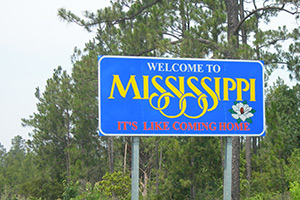Drought Cracks Pavement, Causing Headaches in Mississippi

The National Weather Service said parts of Mississippi suffered through “exceptional” drought from September to November, while the rest experienced “moderate” drought. Soil moisture was well below throughout the state.
“This drought has been something we haven’t seen in over 20 years, a drought this late in the year from one end of the state to the other,” MDOT Executive Director Melinda McGrath told Transport Topics. “It’s caused more damage than we’ve seen in a long time.”
In response, McGrath, said, “We’re actually having to go out and put patches on sections of highway that are breaking off 4 or 5 feet from the edge and are down anywhere from 4 to 18 inches. And now we’re getting below freezing some nights, and the cracks haven’t all been filled up. If the water gets in there and freezes, it’s a problem.”
The cracked pavement above the state’s clay-like soil obviously is a problem for freight movement in Mississippi.
“A drought on the Yazoo clay only exacerbates an already critical problem with our infrastructure,” Mississippi Trucking Association President Hal Miller said. “These maintenance issues create not only an inconvenience due to closures and an additional expense due to equipment wear and tear, but, most importantly, can create unsafe operating conditions for the motoring public.”
Although the Reason Foundation rates MDOT among the nation’s eight most cost-effective state DOTs, Mississippi ranks 21st for the percentage of its bridges that are in deficient condition and 30th for the condition of its rural interstates. Mississippi hasn’t raised fuel taxes since 1987.
Each fall, MDOT establishes a pavement paving schedule for the following spring. The drought has made that more complicated this year. MDOT resurfaced only 660 of its 30,000 highway miles in fiscal 2016 while spending nearly $210 million on what the department calls routine maintenance such as overlays, restriping, patching potholes, chip-sealing roadways and controlling invasive plants.
“We’re going to have to really re-evaluate all of our roads because sections of roadway that were paved this summer or last summer are some of the roads that have huge cracks in them,” she said. “The best thing we can do is to seal our pavement, but that won’t stop the effects of extreme drought because that occurs down deep. If we don’t get additional funding, then all we’re doing is managing to fix the worst of our worst roads.”

